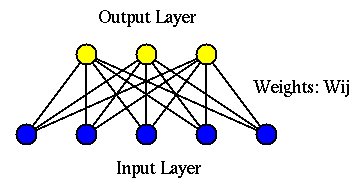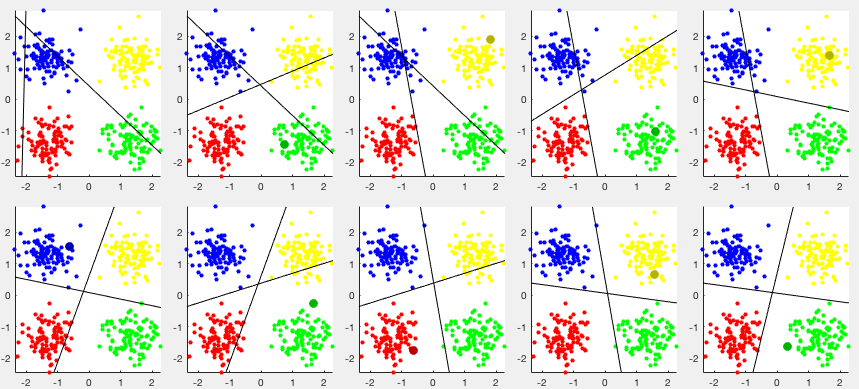Next: Back Propagation Up: ch10 Previous: Hopfield Network
The perceptron network (F. Rosenblatt, 1957) is a
two-layer learning network containing an input layer of 

![${\bf X}=[{\bf x}_1,\cdots,{\bf x}_N]$](img121.svg)
![${\bf x}=[x_1,\cdots,x_d]^T$](img44.svg)
![${\bf y}=[y_1,\cdots,y_N]^T$](img122.svg)


![${\bf w}=[w_1,\cdots,w_d]^T$](img123.svg)








We first consider the special case where the output layer has
only 







If then then |
(29) |
 by
by
 , we get
, we get
 |
(30) |
 is the
projection of
is the
projection of  onto the normal direction
onto the normal direction  of the partitioning hyperplane, and
of the partitioning hyperplane, and
 is
the vector from the origin to the hyperplane (
is
the vector from the origin to the hyperplane ( is the
distance of the hyperplane to the origin). Now the
classification above can be rewritten as
is the
distance of the hyperplane to the origin). Now the
classification above can be rewritten as
If then then |
(31) |
 is classified into either of the two classes
based on the projection
is classified into either of the two classes
based on the projection
 of
of  onto
onto
 , which is either greater or smaller than the bias
, which is either greater or smaller than the bias
 , depending on whether
, depending on whether  is on the positive or
negative side of the plane.
is on the positive or
negative side of the plane.
In all these binary classification methods the parameters








We now consider specifically the training algorithm of the
perceptron network as a binary classifier. As always, we
redefine the data vector as
![${\bf x}=[x_0=1,x_1,\cdots,x_n]^T$](img148.svg)
![${\bf w}=[w_0=b,w_1,\cdots,w_n]^T$](img149.svg)

The randomly initialized weight vector 

 is the step size but here called the
learning rate, which is assumed to be 1 in the
following for simplicity. We can show that by the iteration
above,
is the step size but here called the
learning rate, which is assumed to be 1 in the
following for simplicity. We can show that by the iteration
above,  is modified in such a way that the error
is modified in such a way that the error
 is always reduced.
is always reduced.
When a training sample 



 |
(33) |
 , the
error is
, the
error is
 , and the weight vector
, and the weight vector
 is not
modified. But in cases 2 and 3
is not
modified. But in cases 2 and 3
 , the error
is
, the error
is
 , the weight vector
, the weight vector  is modified
in either of the following two ways:
is modified
in either of the following two ways:
 , but
, but  , then
, then
 and
and
 , we have
When the same
, we have
When the same  is presented to the network again in the
future, the function is smaller than its previous value
is presented to the network again in the
future, the function is smaller than its previous value
 |
(35) |
 is more likely to be the same as the
desired
is more likely to be the same as the
desired  .
.
 , but
, but
 , then
, then
 and
and  , we have
When the same
, we have
When the same  is presented again, the function is
greater than its previoius value
is presented again, the function is
greater than its previoius value
 |
(37) |
 is more likely to be the same as the
desired
is more likely to be the same as the
desired  .
.
 and
Eq. (36) for
and
Eq. (36) for  can be combined to become
where the scaling constant
can be combined to become
where the scaling constant  is dropped as it can be absorbed
into the learning rate if we let
is dropped as it can be absorbed
into the learning rate if we let  . Now the learning rule
can be rewritten as:
. Now the learning rule
can be rewritten as:
If then then |
(39) |
In summary, the learning law guarantees that the weight vector





This binary classifier with 


![${\bf W}=[{\bf w}_1,\cdots,{\bf w}_m]$](img181.svg)












 or or |
(40) |
 output nodes form an m-dimensional binary vector
output nodes form an m-dimensional binary vector
![$\hat{\bf y}=[\hat{y}_1,\cdots,\hat{y}_m]^T$](img193.svg) , which is to be compared
with the labeling
, which is to be compared
with the labeling  of the current input
of the current input  with error
with error
 . When the training is complete, an
unlabeled input
. When the training is complete, an
unlabeled input  is classified to one of the
is classified to one of the  classes with
a matching label to the perceptron's output. In the case of one-hot
encoding, it is possible for the binary output
classes with
a matching label to the perceptron's output. In the case of one-hot
encoding, it is possible for the binary output  to not match
any of the
to not match
any of the  one-hot encoded classes (e.g.,
one-hot encoded classes (e.g.,
![$\hat{\bf y}=[-1\;1\;-1\;1]^T$](img195.svg) . In this case, the input
. In this case, the input  can
be classified to the class corresponding to the node with the greatest
output value
can
be classified to the class corresponding to the node with the greatest
output value
 .
.
The Matlab code for the essential part of the algorithm is listed
below. Array 






[X Y]=DataOneHot; % get data
K=length(unique(Y','rows')) % number of classes
X=[ones(1,N); X]; % data augmentation
[d N]=size(X); % number of dimensions and number of samples
m=size(Y,1); % number of output nodes
W=2*rand(d,m)-1; % random initialization of weights
eta=1;
nt=10^4; % maximum number of iteration
for it=1:nt
n=randi([1 N]); % random index
x=X(:,n); % pick a training sample x
y=Y(:,n); % label of x
yhat=sign(W'*x); % binary output
delta=y-yhat; % error between desired and actual outputs
for i=1:m
W(:,i)=W(:,i)+eta*delta(i)*x; % update weights for all K output nodes
end
if ~mod(it,N) % test for every epoch
er=test(X,Y,W);
if er<10^(-9)
break
end
end
end
This is the function that test the training set based on estimated weight
vectors in 
function er=test(X,Y,W) % test based on estimated W,
[d N]=size(X);
Ne=0; % number of misclassifications
for n=1:N
x=X(:,n);
yhat=sign(W'*x);
delta=Y(:,n)-yhat;
if any(delta) % if misclassification occurs to some output nodes
Ne=Ne+1; % update number of misclassifications
end
end
er=Ne/N; % error percentage
end
This is the code that generates the training set labeled by either one-hot or binary encoding method:
function [X,Y]=DataOneHot
d=3;
K=8;
onehot=1; % onehot=0 for binary encoding
Means=[ -1 -1 -1 -1 1 1 1 1;
-1 -1 1 1 -1 -1 1 1;
-1 1 -1 1 -1 1 -1 1];
Nk=50*ones(1,K);
N=sum(Nk); % total number of samples
X=[];
Y=[];
s=0.4;
s=0.2;
for k=1:K % for each of the K classes
Xk=Means(:,k)+s*randn(d,Nk(k));
if onehot
Yk=-ones(K,Nk(k));
Yk(k,:)=1;
else % binary encoding
dy=ceil(log2(K));
y=2*de2bi(k-1,dy)-1;
Yk=repmat(y',1,Nk(k));
end
X=[X Xk];
Y=[Y Yk];
end
Visualize(X,Y)
end
Examples
The figure below shows the classification results of a perceptron
network with 


![${\bf y}=[y_1,\,y_2]$](img201.svg)





The figure below shows the classification results of a perceptron of







The main contraint of the perceptron algorithm as a binary
classifier that the two classes are linearly separable can be
removed by the kernel method, once the algorithm is modified in
such a way that all data samples appear in the form of an inner
product. Consider first the training process in which the 






 is the number of times sample
is the number of times sample  labeled
by
labeled
by  is misclassified. Upon receiving a new training sample
is misclassified. Upon receiving a new training sample
 labeled by
labeled by  , we have
, we have
 and and |
(42) |
 is updated by the delta-rule:
is updated by the delta-rule:
| If |  |
||
| then |  |
||
 i.e. i.e. |
(43) |
 need to be updated
during the training process, while the weight vector
need to be updated
during the training process, while the weight vector  in
Eq. (41) no longer needs to be explicitly
calculated. Once the training process is complete, any unlabeled
in
Eq. (41) no longer needs to be explicitly
calculated. Once the training process is complete, any unlabeled
 can be classified into either of the two classes based
on
can be classified into either of the two classes based
on
 :
:
If then then |
(44) |
As all data samples appear in the form of inner product in both
the training and testing phase, the kernel method can be applied to
replace the inner product




Here is the Matlab code segment for the most essential parts of the kernel perceptron algorithm:
[X Y]=Data; % get dataset
[d N]=size(X); % d: dimension, N: number of training samples
X=[ones(1,N); X]; % augmented data
m=size(Y,1); % number of output nodes
A=zeros(m,N); % initialize alpha for all m output nodes and N samples
K=Kernel(X,X); % get kernel matrix of all N samples
for it=1:nt
n=randi([1 N]); % random index
x=X(:,n); % pick a training sample
y=Y(:,n); % and its label
yhat=sign((A.*Y)*K(:,n)); % get yhat
delta=Y(:,n)-yhat; % error between desired and actual output
for i=1:m % for each output node
if delta(i)~=0 % if a misclassification
A(i,n)=A(i,n)+1; % update the corresponding alpha
end
end
if ~mod(it,N) % test for every epoch
er=test(X,Y,A); % percentage of misclassification
if er<10^(-9)
break
end
end
end
function er=test(X,Y,A) % function for testing
[d N]=size(X); % d: dimension, N: number of training samples
m=size(Y,1);
Ne=0; % initialize number of misclassifications
for n=1:N % for all N training samples
x=X(:,n); % get the nth sample
y=Y(:,n); % and its label
f=(A.*Y)*Kernel(X,x); % f(x)
yhat=sign(f); % yhat=sign(f(x))
if norm(y-yhat)~=0 % misclassification at some output nodes
Ne=Ne+1; % increase number of misclassification
end
end
er=Ne/N; % percentage of misclassification
end
Example:
The kernel perceptron is applied to the dataset of handwritten
digits of 



![$\displaystyle \left[\begin{array}{rrrrrrrrrr}
116 & 0 & 0 & 0 & 0 & 0 & 0 & 0 &...
... 1 & 3 & 93 & 4\\
1 & 2 & 0 & 1 & 7 & 0 & 0 & 3 & 6 & 96\\
\end{array}\right]$](img231.svg) |
(45) |
The constraint of the perceptron algorithm is the requirement that the classes are linear saperabe due to the fact that there is only one level of learning taking place between the output and input layers. This constraint of linear separablity will be removed when multi-layer networks are used, such as the back propagation algorithm to be discussed in the next section, and more generally, the deep learning networks containing a large number of learning layers between the input and output layers.